 |
Imagine for a moment our home as we know it without wild animals. For me a place like that is unimaginable. Frightening. Sadly however every day that goes by we allow another animal to go extinct; most recently the Black Rhinos. In May I had a life changing encounter with a black Grey Wolf in Wyoming; she opened my eyes to a dream I had put away that I had when I was younger, to work with wild animals to make sure that they always had a home. I volunteered in Marine Mammal Rescue for 5 years and every moment was rewarding and is still cherished.
Thru Wild Eyes is a chance for me to start living that dream again, to give back to the animals I love and to make sure that they have homes in our National Parks. 25% of all purchases of images in these galleries are donated back to different charities; Yellowstone Association and more. If you would like the images with the quotes that you will see on some of them, please contact me before ordering.
"If all the beasts were gone, men would die from a great loneliness of spirit. For whatever happens to the beasts also happens to the man. All things are connected."
Chief Seattle
Click on the underlined links below to take you to the image galleries |
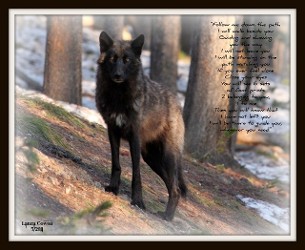 |
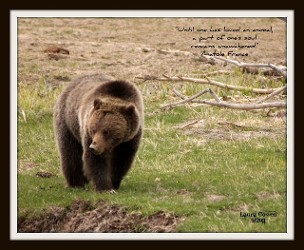 |
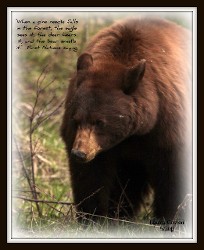 |
Grey Wolves
Wolves once roamed most of the United States until hunted into extinction by people who feared and hated them. In 1995 biologists released wolves back into Yellowstone National Park and in different areas of Idaho. Since then the wolves have made a remarkable comeback and were taken off the endangered species list which has put their numbers and survival in jeopardy once again. I've been blessed to see and photograph wolves in the wild which has inspired me to pursue my interest in wildlife conservation and changed my life. To learn more about wolves, please visit and support:
|
Grizzly Bears
Currently there are only between 1,000 to 1,200 grizzly bears in the lower United States; most are found in Montana, Wyoming and Idaho. In Alaska there are approximately 30,000 grizzly bears. The power and strength of these remarkable animals will take your breath away. The cause of most grizzly bear deaths is due to humans lack of knowledge; hiking unprepared in bear country as well as feeding bears and habituating them to people causing them to be destroyed. Loss of habitat is also becoming an issue as these large bears need plenty of space. To learn more about grizzly bears, please visit and support:
|
Black Bears - Cinnamon too!
A black ranges in color from black to blond, and in British Columbia there are even a white subspecies called the Kermode, or Spirit Bear. Black bears can be found throughout the United States and unlike the grizzly bear, they are not endangered. To learn more about black bears, please visit and support:
|
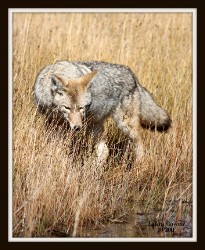 |
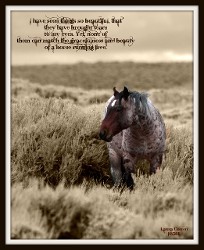 |
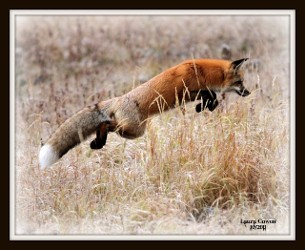 |
Coyotes
Coyotes can be found all over the United States and have adapted to even living in most of our larger cities. Known as tricksters by Native Americans they have learned to live in all different types of environments. They tend to be shy and skittish animals and run when approached by people. They range in colors from rust red to light greys depending on the area they live in. |
Mustangs
Wild mustangs are found throughout most of the western states however the herds are in danger of being rounded up to be auctioned off by the BLM due to the pressure of ranchers who want to graze cattle on the lands the mustangs call home. Mustangs are most often rounded up with helicopters which pursue them for miles at a time at high rates of speed over all kinds of terrain and in all types of weather. This includes newborn foals whose hooves and legs are nowhere near strong enough to endure this sort of travel. Many horses are killed and severely injured during these round ups. I consider it an honor to be able to photograph these animals where they belong; wild and free! Please consider helping these wonderful animals by visiting websites like:
|
Fox
Three dog days in Yellowstone or the Grand Tetons include wolves, coyotes and fox. That makes for a great day! Fox are great at hunting small rodents and while watching them hunt I don't think I have yet to see one not be successful. They are very athletic and curious and will often approach people in the wild to investigate. It is important to remember they are still a wild animal and their survival depends on us not habituating them to us. |
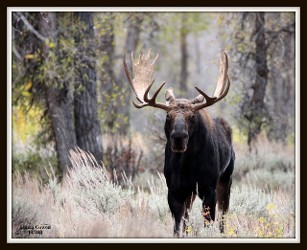 |
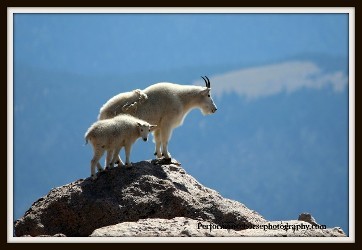 |
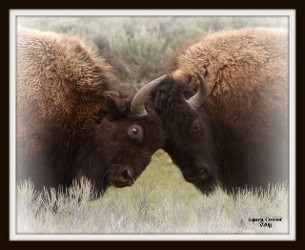 |
Moose
I've always loved moose and even took a trip to Alaska to see them because I had heard that they walk right down the middle of the roads there. I was disappointed to only see one moose in 7 days on that trip! I found out on my way home that moose hunting season was opening in a couple of days; they must be extremely smart to know when hunting season starts. Luckily the moose in Yellowstone and the Grand Tetons are not so camera shy. In October 2011 I photographed 8 different moose including a cow with twins. Please note that one of the bull moose has a rope around his antlers. Although not very pretty to photograph it is an important reminder about how important it is to pick up what we bring into their home with us. |
Sheep, Elk & Deer
Within about an hour's drive from my home here in Colorado I was stunned at the beauty I found in Mt. Evans. I had yet to find the white Rocky Mountain Goats in Yellowstone, so when I was able to photograph two herds here in Colorado I was very excited. If you have yet to visit these remarkable animals, I suggest you take the time to do so. Their balance and grace is unbelievable. |
Bison
It is hard to believe that bison use to make the plains appear black and the ground shake due to the numbers that use to roam there. Bison cause many traffic jams in Yellowstone and are to be respected at all times. Although they appear sluggish they can be very temperamental and charge without warning. They are responsible for more injuries in the parks than bears. Cows are very protective over their calves and a herd will surround them when predators are threatening. |
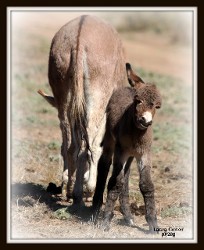 |
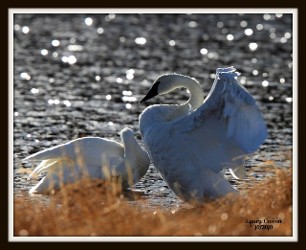 |
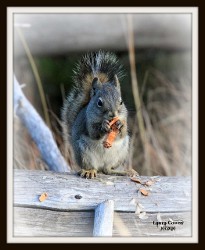 |
Wild Burros
Here in my area we have herds of wild burros who have adapted to living closely to the city and many people. Rumored to have been set free back in the 1950's, a small handful of burros they have now become small herds that number over 250. The burros are watched over and cared for by the people that live in the area. |
Swans, Geese, Hawks, Owls & Other Birds
I'll be honest, I'm terrified of birds! And I like to stay a very safe distance away from them. Birds of prey however really fascinate me; very powerful and great hunters for their size. Its exciting to see a hawk fly down and grab a snake and take to flight again. And the speed at which a blue bird can fly is amazing! |
All the Other Little Ones.....
When there is a slow day while hiking or looking for the larger animals I love to photograph I find it fun to watch and photograph the little ones that most people often overlook. Chipmunks, squirrels and badgers are entertaining, very challenging to photograph. |
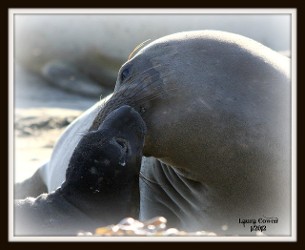 |
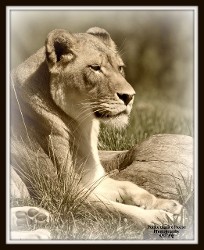 |
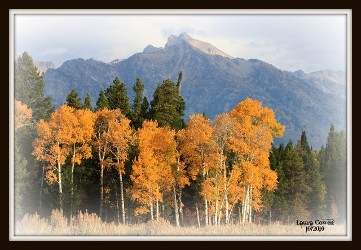 |
Seals and sea lions hold a special place in my heart as I spent 6 years doing marine mammal rescue work. It was the most rewarding work I have ever been involved in. In the 1880's Northern Elephant Seals were hunted to near extinction by whalers for the blubber which is rich in oil. At that time there were only between 20 to 100 animals left. Since being protected by the Marine Mammal Protection Act they are a remarkable recovery story and their numbers are believed to be around 170,000 now. On the central California coast line females come ashore to give birth in late December through February. The large males follow a few weeks later. The pups are born black and weigh about 50 to 60 pounds. They are very curious animals and entertaining to watch. Vultures and shore birds stick around close by to clean up the beach and make for wonderful photo opportunities as well. For more information, please visit and support:
|
Sadly we will only be able to see these animals in captive situations in the US. Some people think these big cats will make great pets and by the time they realize the truth, it is too late and most of these gorgeous animals are destroyed. Some get lucky and are taken in by rescue organizations. I'm lucky enough to have one of these great organizations close to my home in Colorado where they taken in captive animals where they will live out the rest of their lives in large enclosures, allowed to roam "free" with other large cats. These groups are always in need of support.
http://www.wildanimalsanctuary.org/ |
We are blessed to live in a country where we are surrounded by some of the most wonderful scenery on earth. From the pine and aspen forests of The Grand Tetons, to the rocky shores of the central California coast line, to the rock formations of the Grand Canyon and Zion we are surrounded! Please step outside and take some time to visit these areas. |
|
|
|
|
|
 |
|
 |
